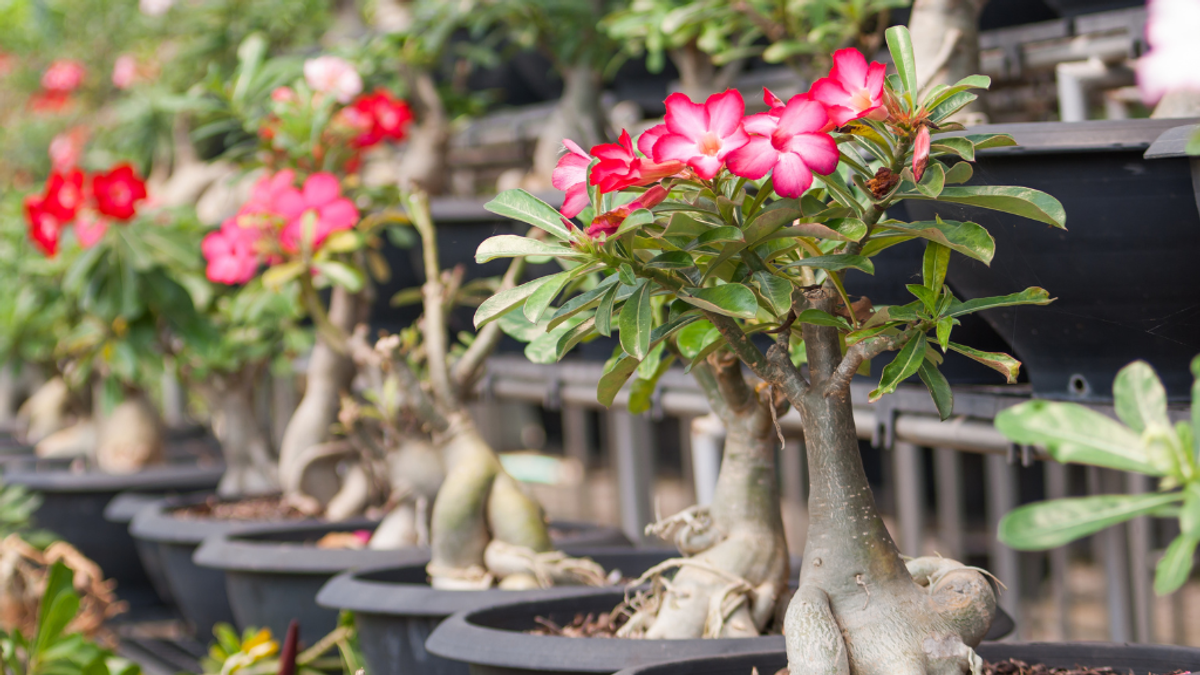
The Adenium desert rose plant is a slow-growing, flowering plant known for its vibrant deep pink flowers, and is frequently grown as a bonsai plant amongst enthusiasts. It is part of a genus of flowering plants in the Apocynaceae family and native to arid or semi-arid climates, but adapts well in tropical or semi-tropical environments too. Adeniums can be found in Africa, Madagascar, and the Middle East.
Although it is widely used as an ornamental outdoor plant, the Adenium can also be grown in cooler zones indoors or as an addition to a patio display. However, Adenium desert rose plants do require full sunlight and well-drained soil, mimicking their native regional environments in order to properly grow and bloom. Without proper care and knowledge, maintaining the life cycle of this plant can be difficult, but novice plant enthusiasts shouldn't shy away from adding the Adenium desert rose to their collection.
Why is it called "Adenium"?
The beautiful Adenium has been a known desert plant for hundreds of years with the first sighting dating back to 1761 by Finnish scientist, Pehr Forsskal, on an exploration voyage to the regions of Egypt, Arab, and India. Only a year later, in 1762, he caught sight of it again in Yemen.
It was then decided that this newly discovered plant species should be called "Aden," the former name of the country Yemen, referring to the Yemen region and Arabian Peninsula from the Red Sea to the Indian Ocean.
Over the hundreds of years since it has been found, the Adenium also goes by many names in different parts of the world:
English: Elephant Foot, Sabi Star, Karoose Rose, Impala lily
Thai: Chuan Chorn, Kalachuchi
French: Rose Du Desért, French Asalée
- Portuguese: Rosa Do Deserto
Identifying Adenium Desert Rose Species
The Adenium family comes in a variety of species — up to 12 or more known species! These species range from common to rare ones. It is, therefore, important to know which species you have to give it proper care.
Here are 8 Adenium species:
3 Most Common Species
Adenium Obesum

Region: African Sub-Saharan region (Senegal, Sudan, and Kenya), Tanzania, Somalia, Socotra
Average Height: 3ft (0.9m) to over 9ft (2.7m)
Flower Colour: Dark crimson red
Features: Greenish-grey trunk; thick caudex that gets slimmer on the top and branches; leaves look like long droplets
Adenium Arabicum
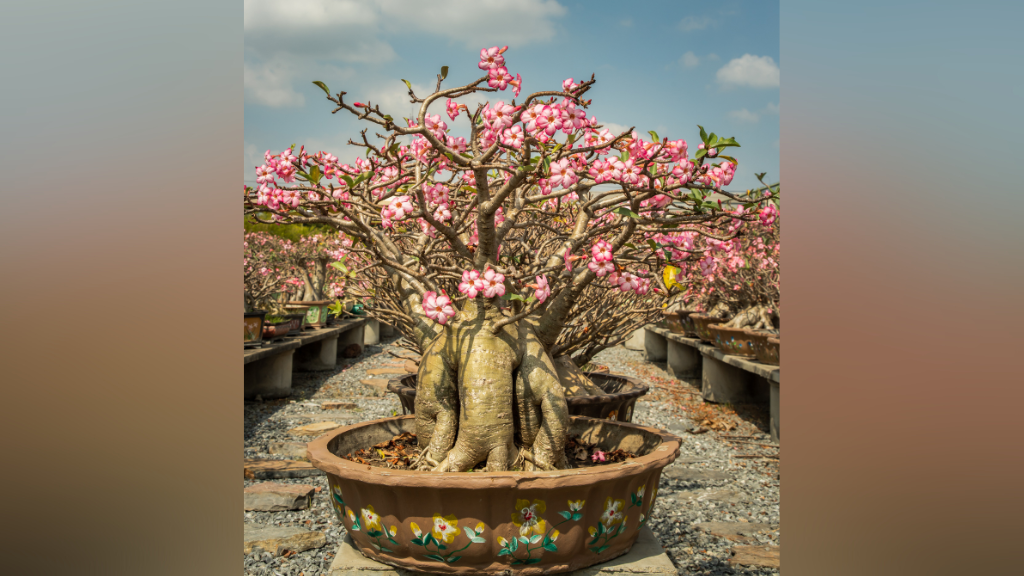
Region: Arabian Peninsula, Saudi Arabia, Oman, Yemen
Average Height: 3ft (0.9m) to over 11ft (3.3m)
Flower Colour: Pale pink with red marks on each petal; Occasionally white
Features: Short, chubby leaves concentrated at the top; chunky caudex with big trunk; fewer branches that are strong and firm
Other Varieties: Adenium Yak Saudi, Adenium SuayNamPetch, Adenium MK-MK, Adenium Godji, and many more
Adenium Multiflorum
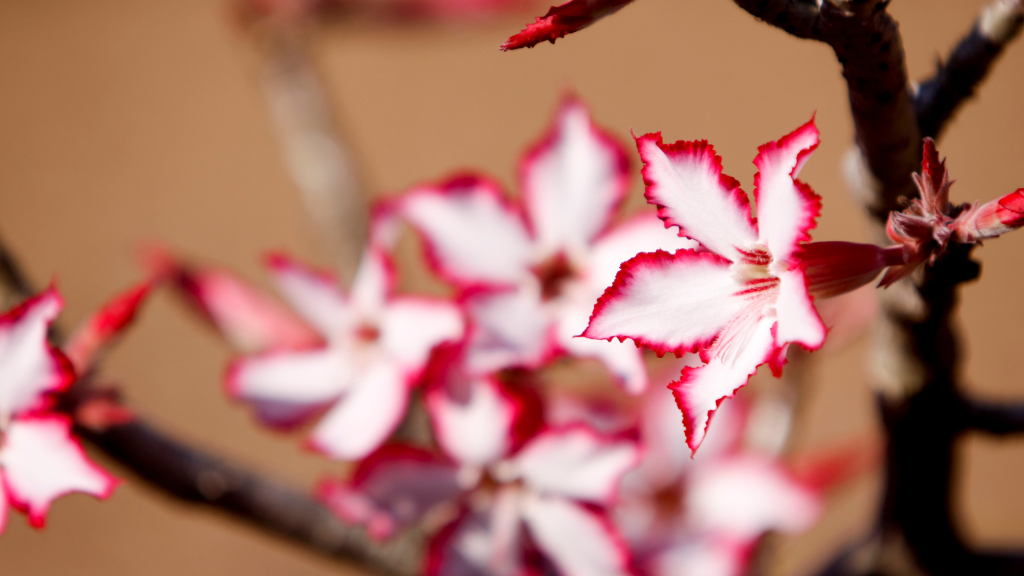
Region: South Africa, Zimbabwe, Mozambique
Average Height: 2ft (0.6m) to 9ft (2.7m)
Flower Colour: Crimson red near edges, white in the centre, red stripes near flower throat
Features: Long, glossy green with rounded tip leaves; glossy grey to brown bark; produces a highly poisonous sap when the branch is broken off
5 Other Species Varieties
Adenium Swazicum

Region: Eswatini, Mpumalanga
Average Height: Shorter than 3ft (0.9m)
Flower Colour: Ranges from light pink and dark pink to crimson red
Features: Narrow flower tube; flower colour is uniform all around; narrow and long leaves; slender and soft trunk
Adenium Somalense
Region: Tanzania, Kenya
Average Height: Over 13ft (3.9m)
Flower Colour: pink
Features: Caudex is the same size as its long trunk
Adenium Crispum

Region: Coast of Southern Somalia
Average Height: Shorter than 20 inches (50cm)
Flower Colour: Reddish, pink, and white shades
Features: Leaves are long, narrowly linear that are reddish-green with a white midrib and silvery veins
Adenium Boehmianum
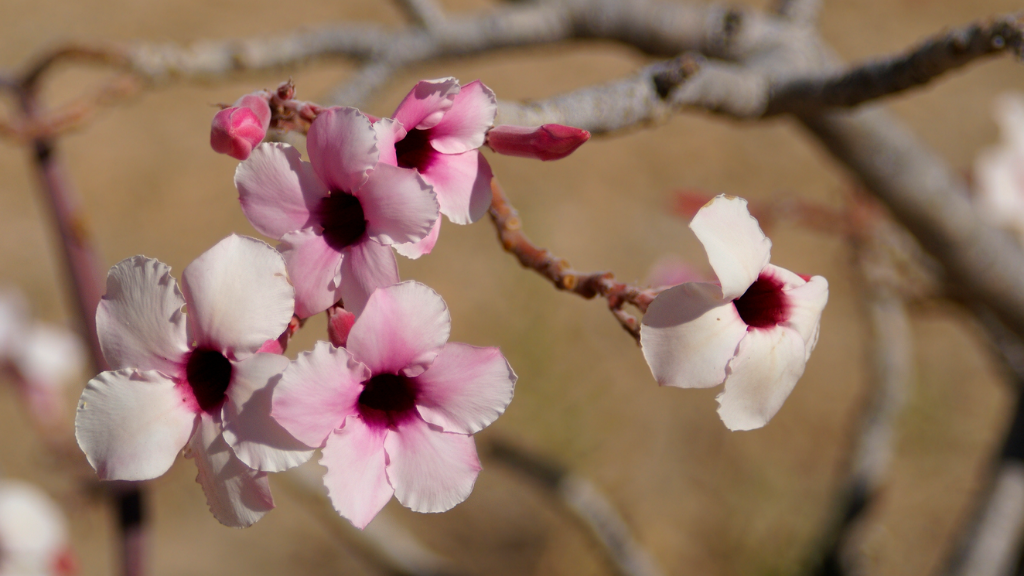
Region: Namibia, Angola
Average Height: 4ft (1.2m) to 5ft (1.5m)
Flower Colour: Pale pink on petals with darker hue in the tube
Features: Big, non-glossy leaves
Adenium Oleifolium
Region: Kalahari Desert of Southern Botswana, Namibia, and South Africa
Average Height: 0.4m
Flower Colour: Ranges from pink to red
Features: Slow growth rate; leaves are long and narrow, greenish-grey in colour; powdery dust surface
Adenium Socotranum
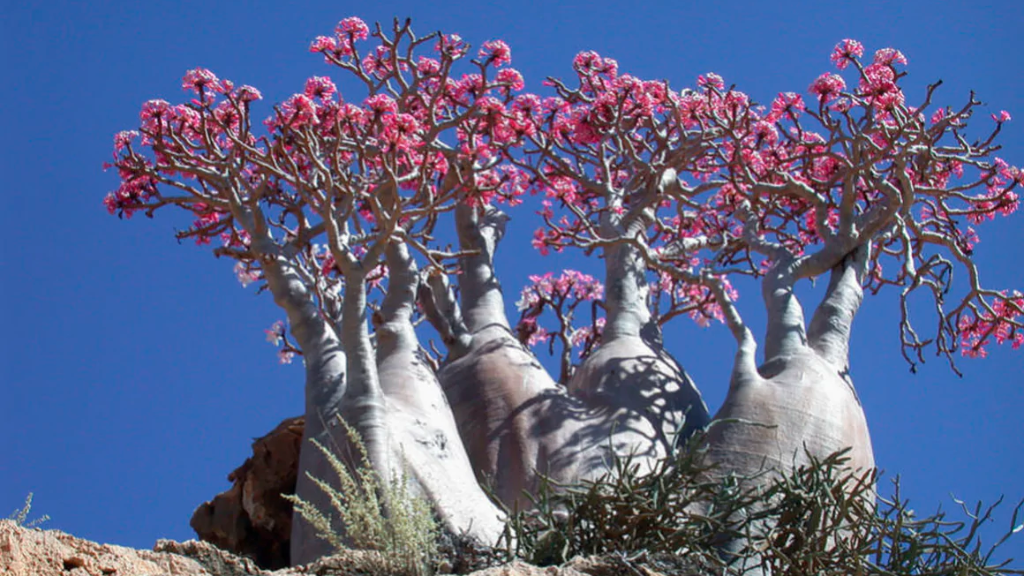
Region: Socotra island in the Indian Ocean and Arabian Sea
Average Height: 13ft (3.9m) to 16ft (4.8m).
Flower Colour: Light pink
Features: Very chubby caudex; short, thin and twiggy branches; smooth, dark green leaves that grow wider near the tip
Basic Knowledge on Adenium Desert Rose
As a succulent plant, Adeniums have a water storage system in their leaves, stems, or roots, which means they do not require too much watering. Too much water left in the soil for extended periods of time can cause their roots to rot.
An indicator for a healthy plant is a well developed caudex (swollen trunk), something distinctive to this plant class. A generally low maintenance plant, it is important to note the water, temperature, and lighting needs of the Adenium to create an optimum environment for it to thrive. Adenium requires less water than other plans average and normally prefer being in full sunlight at temperatures of around 18℃ to 32℃.
Propagating Adenium
From a seed
Propagating an Adenium as a seed is quite simple. To get started, you would first need to find a container to place the seed in, fill it with a potting medium, and add just enough water. You only need to water it every 4 to 5 days, making sure that the planter does not sit in water all day; remove excess water as soon as the soil is damp. As for the temperature, it needs to remain within 26℃ to 29℃ to germinate successfully. Once the seeds have germinated, the seedlings require watering from the bottom. Continue this process and monitor the seedlings; they should be ready for replantation in a month.
From a cutting
Propagating Adenium from a cutting requires a little bit more work and care than a seed.
The ideal length to root an Adenium cutting should be at least 6 inches. Dry them with a paper towel or by laying them out on a newspaper, making sure to keep them out of direct sunlight for 48 hours.
Once they are fully dry, prepare gravelly, well-drained potting mix in a pot or container. You can opt to make your own mix with equal amounts of potting soil, coco coir or peat moss, sand and/or very fine gravel, or simply use an off-the-shelf, commercial mix (the same ones intended for cactus and succulents). For good drainage, place coarse gravel at the bottom of the pot or container.
Before potting, lightly dust the cut end with rooting powder and poke it into the planting mix. Avoid water-logging the roots by using a spray bottle to soak the planting mixture, and mist it every few days to keep the soil moist, not drenched. Thereafter, you can proceed to place the developing plant in a warm, bright area where it is easy for you to keep an eye on. Make sure the plant can get even sunlight, so turn the plant every so often or you will get a plant that is bent towards the source of sunlight.
You can tell that it is ready to be moved to a sunnier spot once your Adenium plant starts to sprout new leaves. Once it gets more mature and well-rooted, it can be replanted directly into the ground outdoors. Having said that, planting it in a container is more convenient for relocation during wetter seasons.
Additionally, with this method of propagation, the plant will only develop its signature chunky caudex below the soil level and slowly exposes as it matures.
Fertilising and Repotting Adenium
It is important to provide a light feeding of slow-release fertiliser or water-soluble liquid fertiliser periodically during the Adenium's growing season.
Since Adenium is a slow-growing plant, frequent repotting isn't necessary — once every two or three years is ideal. An adequate-sized container that will allow root mass growth an extra one or two inches will encourage more blooms whereas a container that is too big will encourage root growth, but reduce the number of blooms. Keep your Adenium fresh by shaking off old soil from its roots before repotting into a new, well-draining soil mix.
Pests and Other Adenium-Related Problems
As with most outdoor plants, the Adenium has a tendency to attract some critters into your garden. These include:
Asphids (remedy with neem oil treatment insecticides)
Spider mites (remove damaged leaves, remove top 2 inches of potting mix, replace with new mix, and spray neem oil treatment insecticides)
Mealy bugs (remedy with neem oil treatment insecticides)
Plant insect scales (remedy with neem oil treatment insecticides)
- Oleander caterpillars (pick them by hand with gloves on, treat with Bacillus Thuringiensis)
Besides these pesky pests, if you notice that your plant is developing tan lesions before turning yellow and falling off, it is most likely due to a fungal disease called 'Anthracnose' — a common issue among Adenium plants. It usually occurs during the summer or spring seasons, and typically recovers on its own with reduced watering and removal of fallen leaves.
Lastly, as mentioned earlier, root rot is a pervasive problem when it comes to the Adenium. Overwatering it will cause its roots to rot. Similar to a succulent and cactus, these plants can retain water in their thick roots and do not require frequent watering to thrive. It is better to underwater your Adenium, ensuring the drainage system of your container is well, than running into the issue of root rot.
Want to keep your Adeniums healthy? Our HB-101 fully organic plant 'vitaliser' is specially formulated without chemicals by blending the extracts of cedars, pines, cypress trees, and plantains. This all-natural extract supports plant growth, improves soil conditions, promotes flowering, strengthens roots, and improves photosynthesis, among many others. To shop our HB-101 plant vitalises, click here or visit our store on Shopee.


